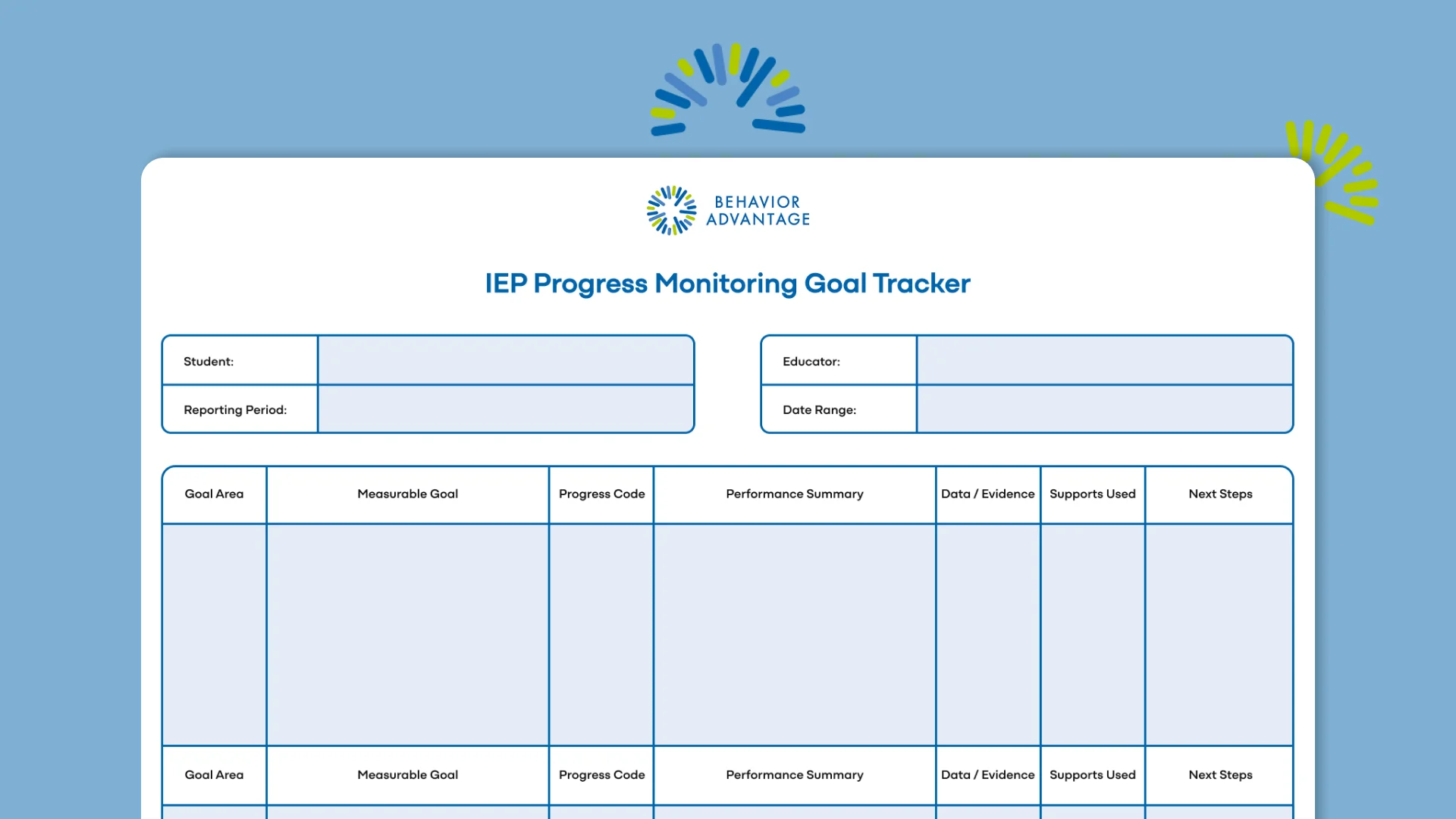For students with disabilities, the Individualized Education Program (IEP) is more than a plan—it’s a legal commitment to helping them achieve meaningful, measurable outcomes. A critical component of that commitment is the IEP progress report, which tracks how well a student is progressing toward their annual goals.
Under the Individuals with Disabilities Education Act (IDEA), schools are legally required to monitor and report progress on each IEP goal. These updates must be provided to parents at regular intervals—typically alongside report cards or at the end of grading periods. But these reports serve a greater purpose than compliance: they offer essential insight into a child’s growth and help teams make informed instructional decisions.
This guide breaks down:
- What IEP progress reports are and why they matter
- Common mistakes to avoid
- How to write strong, clear, and compliant reports
- A ready-to-use IEP progress report writing template
Download our free IEP Progress Monitoring Goal Tracker

What Are IEP Progress Reports?
IEP progress reports are formal updates that communicate how a student is advancing toward their annual IEP goals. These reports:
- Align with the measurable goals outlined in the IEP.
- Provide clear, data-based evidence of progress (or lack thereof)
- Must be shared with families at regular intervals, per IDEA §300.320(a)(3)
These reports are essential for ensuring that services are effective and that students are being supported in meaningful, personalized ways.
Why IEP Progress Reports Matter
IEP progress reports aren’t just routine paperwork—they’re a vital tool for driving student success and ensuring schools meet their legal and ethical obligations under IDEA. When written with clarity and intention, using the SMART (specific, measurable, attainable, relevant, time-oriented) format for goals during the IEP process, these reports become powerful instruments for advocacy, accountability, and instructional planning.
Here’s what well-crafted IEP progress reports make possible:
Show if a Student is on Track to Meet Their Goals
Progress updates provide a snapshot of how the student is doing compared to the IEP’s annual expectations. They help teams determine if current instruction and interventions are helping the student move forward—or if adjustments are needed.
Need support for writing behavior goals? Check out the Behavior Advantage IEP Goal Bank for examples you can use and adapt right away.
Highlight the Effectiveness of Current Supports
Is the student progressing with accommodations in place? Are pull-out services or behavior plans having the desired impact? Progress reports help identify what’s working and where additional support may be needed.
Provide Legal Documentation of Services and Outcomes
Under IDEA, schools are required to measure and report progress. A well-documented progress report becomes part of the student’s official record and can demonstrate that the school is fulfilling its obligation to provide a Free Appropriate Public Education (FAPE).
Keep Teachers and Families Aligned
Clear, jargon-free summaries of student performance ensure that families aren’t left guessing. When educators use consistent data and plain language, parents can better understand how their child is doing—and how they can be part of the support system.
Our recent blog article : Presenting a Behavior Plan at an IEP Meeting – A Human-Centered Approach can help prepare you to discuss behavior with families during IEP meetings to support home-school alignment.
Create System-Wide Accountability
IEP progress reports don’t just reflect on the student—they reflect on the school. They hold teams accountable for delivering high-quality, individualized instruction aligned with the IEP, and they offer administrators insight into the fidelity and effectiveness of implementation across classrooms.
Common Mistakes and How to Avoid Them
Let’s be honest—most of us didn’t learn to write great progress reports in college. Here are a few pitfalls to avoid, and what to do instead:
🚫 Vague language
❌ “He’s doing better with math.”
✅ “Student solved 16 out of 20 problems on two-digit subtraction assessments with 80% accuracy, up from 50% last quarter.”
🚫 No connection to the goal
❌ “She’s more engaged in class.”
✅ “Student initiated peer interactions 3 times per session, meeting the benchmark toward her social communication goal.”
🚫 Lack of evidence
❌ Paragraphs with no numbers or examples don’t paint a clear picture.
✅ Use percentages, frequency, or rubric scores to show real progress.
Using Benchmarks to Track Smaller Wins
For some students—especially those participating in alternate assessments—IDEA requires IEPs to include benchmarks or short-term objectives. Even when not required, benchmarks can be incredibly helpful.
Think of benchmarks as mini-milestones that help break down an annual goal into manageable steps. They’re especially useful for progress monitoring because they offer built-in checkpoints where teams can pause, reflect, and adjust instruction if needed. Benchmarks can easily be woven into IEP progress monitoring reports and shared with families.
Here’s an example:
Annual Goal:
When presented with a non-preferred academic task during math class, and given a break card or visual support, the student will request a 5-minute break using respectful communication and return to their assigned seat within 6 minutes in 4 out of 5 opportunities.
Benchmarks:
- Within 3 months, the student will request a break in 2 out of 5 opportunities, with adult prompting.
- Within 6 months, the student will request a break and return within 8 minutes in 3 out of 5 opportunities.
- Within 9 months, the student will independently request a break and return within 6 minutes in 4 out of 5 opportunities.
Tracking progress toward these smaller benchmarks makes it easier to celebrate progress—even if the full goal isn’t met yet—and helps inform next steps for instruction or support.
Putting It All Together: Example IEP Progress Monitoring Reports
Now that we’ve covered the what, why, and how of IEP progress reporting, let’s bring it all together with real-world examples. Below you’ll find sample progress notes written for the same behavioral goal—each one showing a different level of student progress. These examples follow IDEA-aligned best practices and demonstrate how to write clear, data-driven, and actionable updates that keep teams informed and students supported.
Example 1 – Goal Met
Student Name: Jordan M.
Goal Area: Behavior – Reducing Off-Topic Questions
Reporting Period: Quarter 3
IEP Goal: During a 45-minute class period, and given a visual cue system, Jordan will ask at least 2 on-topic questions and fewer than 2 off-topic questions in 4 out of 5 class periods per week, as tracked by the teacher on a simple tally form.
Progress Code: Goal met
Performance Summary:
Jordan has successfully met this behavioral goal. Over the last six weeks, he consistently asked 2 or more on-topic questions per class and rarely asked any off-topic questions. In 18 of the last 20 class sessions, Jordan met or exceeded the goal criteria. He now uses the visual cue card independently, and rarely needs teacher redirection to stay on-topic. This marks significant improvement from earlier in the year, when off-topic questioning was a frequent classroom disruption.
Quantitative Data:
- On-topic questions avg per period: 2.6
- Off-topic questions avg per period: 0.3
- Goal met in: 18/20 class sessions
- Support used: Visual cue (now self-initiated), fading adult prompts
Next Steps:
Fade visual cues and begin generalizing the skill across other class periods and with other teachers.
![]()
Example 2 – Progressing but Not Yet at Target
Student Name: Zoe L.
Goal Area: Behavior – Reducing Off-Topic Questions
Reporting Period: Trimester 2
IEP Goal: During a 45-minute class period, and given a visual cue system, Jordan will ask at least 2 on-topic questions and fewer than 2 off-topic questions in 4 out of 5 class periods per week, as tracked by the teacher on a simple tally form.
Progress Code: Progress made, but not sufficient to meet goal yet
Performance Summary:
Zoe continues to make progress in reducing off-topic questions. She now asks at least 2 on-topic questions in most class periods, which shows growth in classroom engagement and content focus. However, off-topic questions still occur in about half of the monitored periods, particularly during less structured activities. Zoe responds well to visual cues but sometimes needs verbal reminders. While the target behavior hasn’t been reached consistently yet, progress is evident and moving in the right direction.
Quantitative Data:
- On-topic questions avg per period: 2.2
- Off-topic questions avg per period: 2.1
- Goal met in: 8/15 class periods
- Support used: Visual cue card, teacher redirection
Next Steps:
Increase consistency of reinforcement when the goal is met; introduce self-monitoring checklist to help Zoe reflect on her participation during and after class.
![]()
Example 3 – Minimal Progress / Reevaluation Needed
Student Name: Eli T.
Goal Area: Behavior – Reducing Off-Topic Questions
Reporting Period: Quarter 1
Progress Code: Limited progress
Performance Summary:
Eli is not yet demonstrating consistent progress toward the goal of reducing off-topic questions. In most monitored class periods, he continues to ask multiple off-topic questions, often during transitions or independent work. While the visual cue system is in place, Eli requires frequent verbal prompts and sometimes disregards nonverbal cues. The team will revisit the behavior plan to consider alternate strategies and supports.
Quantitative Data:
- On-topic questions avg per period: 1.3
- Off-topic questions avg per period: 3.6
- Goal met in: 2/10 class periods
- Support used: Visual cue, adult prompts (limited effectiveness)
Next Steps:
Schedule a team meeting to review interventions; consider adjusting the goal, increasing reinforcement, or pairing the cue with a more concrete visual or tangible reinforcer.
If you are struggling with writing Behavior IEP Goals, check our guide on the topic!
![]()
Final Thoughts
IEP progress monitoring isn’t just a legal requirement—it’s a meaningful part of supporting student growth. When done well, it helps educators make informed instructional decisions, gives families clarity, and ensures students stay on a path toward success.
While this guide offers a solid foundation for writing and tracking IEP progress reports, it’s also essential to understand your school, district, or state-specific procedures, as they may add additional requirements beyond what IDEA mandates. Staying aligned with both local policies and federal law ensures your progress reporting is both compliant and impactful.
Use these general best practices to make your process more efficient, consistent, and effective—whether you’re supporting one student or managing a full caseload.
Behavior Advantage can help you and your team with the process of preparing an IEP Progress Report.











